#quianzhousaurus
Text
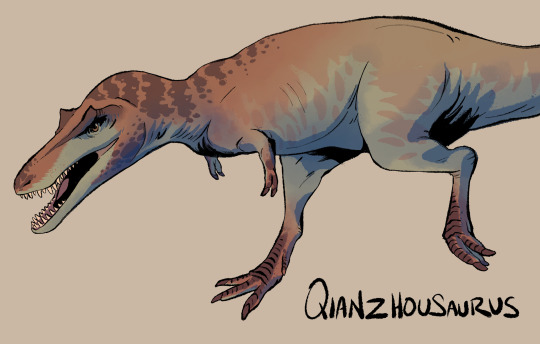



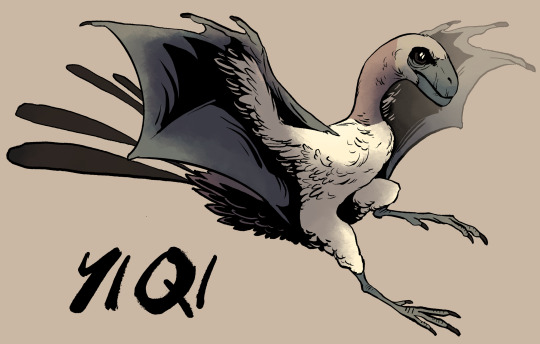
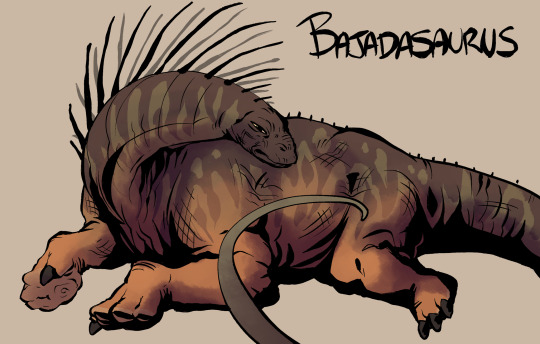

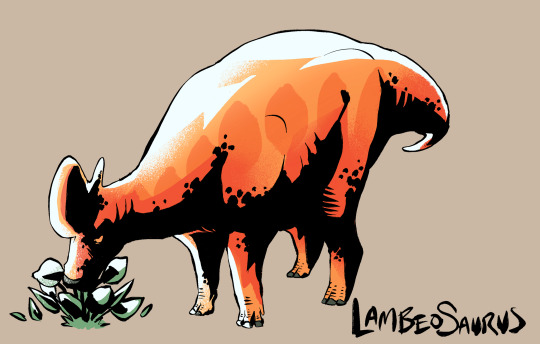


Dinocember 2023 Week 4+
#own art#digital art#dinosaur#dinocember#quianzhousaurus#miragaia#zuniceratops#dilophosaurus#yi qi#bajadasaurus#diabloceratops#lambeosaurus#megaraptor#ankylosaurus#prompts by savage mojo on da#got done a little early#this is the first month long art challenge I’ve ever finished yay#I had fun but I’m so ready to work on something else now lol
70 notes
·
View notes
Text


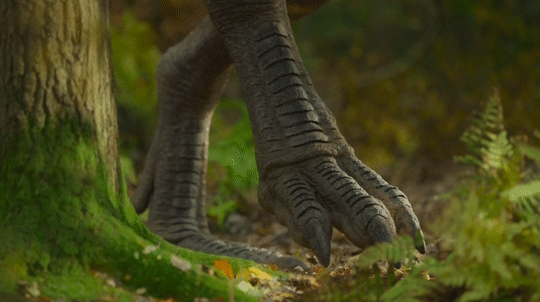

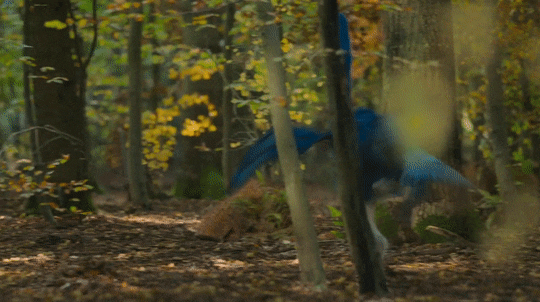


Qianzhousaurus hunts Corythoraptor.
#prehistoric planet#Quianzhousaurus#Corythoraptor#oviraptor#tyrannosaurid#dinosaur#dinosaurs#paleo art#paleoart#feathered dinosaurs#fluffy dino#gif#animals#extinct animals#paleoblr#theropod
661 notes
·
View notes
Text

Day 19- Quianzhousarus
In the shade of a stand of conifers, a lone Quianzhousaurus watches a mammal skitter between the branches
Prompts
#art#my art#digital art#paleoart#dinovember#paleontology#palaeoblr#archosaurs#dinosaurs#theropods#coleurosaurs#tyrannosaurids#alioramids#quianzhousaurus#queue
13 notes
·
View notes
Photo

Hi there!
Warm up sketch: Qianzhousaurus (25mins)
93 notes
·
View notes
Text
Did T. rex Have Feathers?
T.rex by Mark Witton

Hello, this is my first post! Today we will be answering a commonly asked question. This question is a very controversial and is usually answered wrongly. But I will hopefully answering this today and help people understand the truth. So, Did T.rex Have Feathers? Short answer, We don't know for sure, but it most likely is a NO. Now for the long answer.
Phylogeny
Before we go over ANYTHING we first have to go over where T.rex stands in the family tree. And how the phylogeny would work.
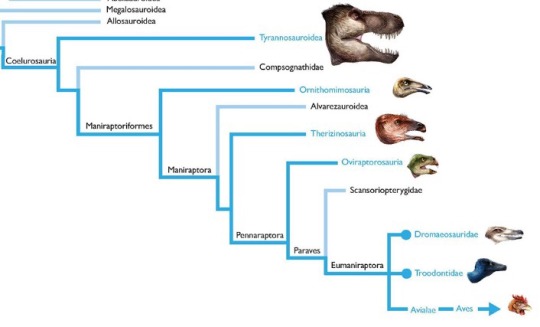
Family tree by Maxwell Yeager
Tyrannosaurus was a Coelurosaurian dinosaur. This group of dinosaurs are closest related to birds. The members of Coelurosauria are Tyrannosauroidea, Compsognathidea, Ornithomimosauria, Therizinosauria, Oviraptorosauria, Scansoriopterygidae, Dromaeosauridea, Troodontidea, avialae, and aves(birds). At least one dinosaur specimen from all of these families preserves feathers or filaments. Now, let's look deeper into Tyrannosauroidea and see what's up.
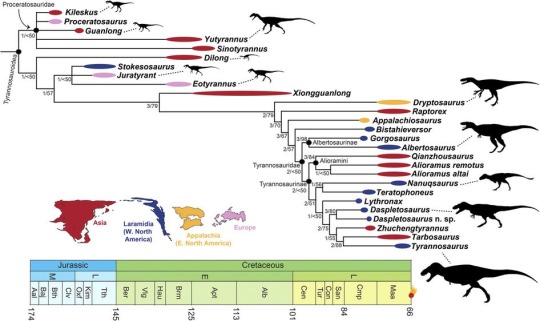
Family tree by https://www.nature.com/articles/srep20252
Tyrannosauroids are the family Tyrannosaurus rex is in. The kin of Tyrannosaurus where definitely feathered. The 2 dinosaurs with this evidence are Yutyrannus huali and Dilong paradoxous. Both MOST LIKELY being in Proceratosauridea. Now, notice a problem. Comparing dinosaurs from completely different branches. Unlike how Trey the Explainer explained it. Phylogenetics usually does not apply to different branches. It's like saying birds have scales (reticula aren't scales) because dinosaurs had scales. Yutyrannus does say that filaments appeared in large dinosaurs as well. But it does not say anything about relatives in Tyrannosauridea having filaments. Let's look even closer into the integument of Tyrannosaurids. Because if you didn't know, Tyrannosauridea has a LOT of preserved skin impressions.

Family tree by Gabriel Ugueto
(note that Bistahieversor should be in Tyrannosauridea as well, Dryptosaurus isn't a Tyrannosaurid but a basal Tyrannosauroid, and we're missing Daspletosaurus Horneri)
The Tyrannosaurid family consists of Alioramus, Quianzhousaurus, Gorgosaurus, Albertosaurus, Bistahieversor, Nanuqsaurus, Teratophoneus, Lythronax, Zhuchengtyrannus, Daspletosaurus, Tarbosaurus, and Tyrannosaurus. Six speicies of these dinosaurs have been found with preserved integument. And the evidence of feathers seems unlikely here. No feathers or filaments of any kind have been found in Tyrannosauridea. Only scales. They may be small impressions (some are quite large). But remember, integument is hard to preserve. Plus, by combining all scales on Tyrannosauridea, onto T.rex. It leaves 0 room for feathers. If there was feathers, it would basically be down it's back.
Integument
Before we go any further. We need to over what integument is. And how it works. Integument is skin of an animal. This includes scales, skin, feathers, hair, etc. Integument can be spiny, rough, hard, fluffy, smooth, you name it. Integument is used in many ways and appears on all life on Earth. Let's look at the main integument on Coelurosaurian dinosaurs and what they where used for.
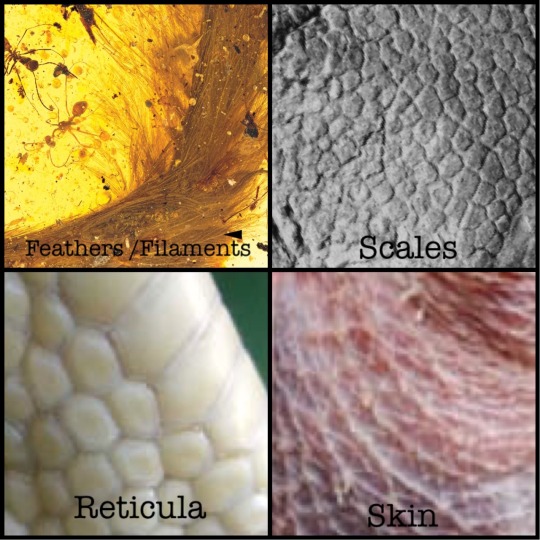
Coelurosauria had basically 4 main integument. Skin, scales, reticula, and feathers/filaments. Filaments are a decedent of scales. Filaments can be found on countless bird and dinosaur speicies. And the most common filament is the feather. Feathers are used for flight, camoflague, mate attraction, warmth, and heat protection. Skin is used to house feathers. Plumage can't exist on top of scales. It can only exist on skin. Non-feather filaments can exist next to both scales and reticula. But feathers have never been seen coexisting with scales. Although is possible we have no evidence. Reticula are not scales. It is seen on the feet of birds and some dinosaurs. Reticula is actually feathers that evolved back into it's ancestral trait. This is why reticula is seen next to feathers. Because reticula aren't scales.
Scales on Tyrannosauridea
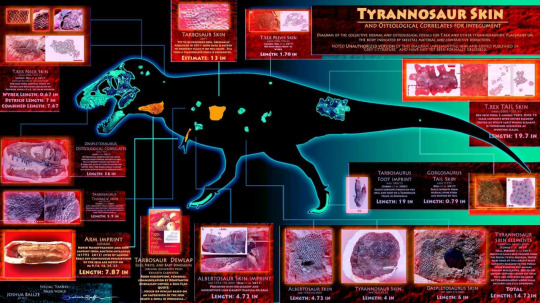
Take a look at this diagram. Scales are found all over the body of Tyrannosauridea. From the tail to the face. Tyrannosaurus rex was discovered with scales in it's neck, feet, tail, legs, and abdomen. Daspletosaurus had scales on it's face and abdomen. Tarbosaurus had scales on it's feet, thorax, and thought. Gorgosaurus had scales on it's tail and abdomen. Albertosaurus had scales on it's abdomen as well. And "Nanotyrannus" had scales on it's arms (Nano doesn't exist). No feathers or resemblance of feathers have been found on any Tyrannosaurids.
In life, the scales of Tyrannosaurus would be very small. Tyrannosaurus would look like it had leathery skin from a far.
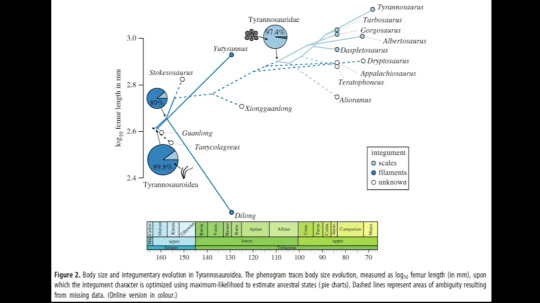
We know that basal Tyrannosauroids had feathers. Yutyrannus and Dilong can prove this. Now, during evolution. Animals gain traits and loose traits. Sometimes traits can form than later seen be lost. Like it was never there. Feathers are definitely an ancestral trait to dinosaurs. Many dinosaurs (especially in Coelurosauria) are seen with filaments. But, that doesn't necessarily mean they can't loose them. So what happened in Tyrannosauridea was called a reversal. A reversal is when an advance condition, turns back into an ancestral condition. The ancestral condition for feathers is scales. So feathers would go back to scales. And that's what we see in Tyrannosaurids. So there is really no reason to say "T.rex had feathers." Because there is no evidence for Tyrannosaurus having plumage.
What This Means

By RhysDylan01 https://rhysdylan01.deviantart.com
Like said before, if T. Rex was feathered. It would be down it's back. Yep, boys and girls this is your feathered Tyrannosaurus. Yeah an animal probably would not need this much feathers. It was probably naked. In fact feathers are more of a disadvantage. In fact we could be looking at a whole other view of feathered dinosaurs.
You see, as dinosaurs got bigger, you can tell they started to loose feathers. Ornithomimids have featherless legs, Tyrannosaurids lost all of their feathers, Sauropods are scaly, large Ornithischians are scaly while small ones remain fluffy. Even birds, our modern dinosaurs loose feathers as they grow. Ostriches and Emus have naked legs and heads. Dinosaurs like Therizinosaurus or Utahraptor might have been partly featherless or completely featherless due to their greatness in size. We might be seeing large dromaeosaurs with naked heads and legs, or a giant featherless Therizinosaurus.
Why Are Feathers a Disadvantage
Feathers can be a large disadvantage for a giant muscular animal. Tyrannosaurus produced a lot of heat. And feathers are good at preventing heat. But they are also good for trapping heat as well.

If you look at these ostriches, notice how the warmest area is where the least amount of feathers are. Downy feathers (which are the type of feathers Tyrannosaurus would most likely posses) are the best at trapping heat. And the heat seems to be most affected on the featherless areas of the bird. So imagine a giant T.rex with feathers. No chance of any survival in that.
Birdisaur_Central on Instagram came up with an interesting theory. It is called the rain theory. Basically large feathered dinosaurs (like Tyrannosaurus) would find feathers as a disadvantage. If it where to rain, large dinosaurs would find it hard to hide. And if they had feathers, the feathers would clog up with water. This would cause stiffness and make dinosaurs easily affected by disease over time.
Lastly, let's use our common since. A Tyrannosaurus with a bright pink feather main to attract all the ladies. Imagine that hiding in a flood plains. How would you stock your prey? You can run 11mph at your prey that can easily out run you. Or you can become a scavenger like Horner says you are. Even though if anything the dromaeosaurid where the scavengers. Tyrannosaurus was most likely an ambush predator, so bright feathers would not be a very nice choice. Plus feathers create drag anyways. That's why raptors "birds of prey" have featherless legs.
Why Did Yutyrannus have Feathers

By Metratton https://metratton.deviantart.com/art/Yutyrannus-WIP-2-731631248
For starters Yutyrannus was a basal Tyrannosauroid. It would take millions of years before Tyrannosauroids lost there fluffy integument. Although it gets deeper than that.
Yutyrannus was not as heavily built as Tyrannosaurus. It didn't produce much heat. So it would not over heat in feathers. Yutyrannus also needed feathers to keep it warm and trap heat anyways. Because of it's cold environment. Yutyrannus also was surprisingly in the "size range" for feathers. Being the biggest discovered with filaments Yutyrannus had closer relatives. Like Sinotyrannus which grew very large as well. Meaning feathers evolved on Sinotyrannus as well. Because both of them where Proceratosaurids.
The Media's Take
The media is surprisingly trying to keep there feathered Tyrannosaurus. Museums to video games to even documentaries all around the world are trying to spread the word of a fluffy Rex. Using little to no evidence. And excusing Yutyrannus and Dilong as evidence when really they aren't any evidence at all. Although some of the Paleontological comunity is accepting the evidence. Even Saurian is going to change their Tyrannosaurus to a scaly one soon.
Common Misconceptions, Myths, and Lies
"Scales and Feathers can coexist with eachother"
This claim is a very childish claim. We have no evidence of this. It is slightly possible but unlikely. And what about Kulindadromeus? Kulindadromeus had scales and filaments! We don't know if they where true feathers or not. But they probably where not. No dinosaur had true feathers and true scales. I say true scales because the feet of birds are not scales. But harden feathers.
"All dinosaurs had feathers"
No. This is simply not true. We only have feathers in Coelurosauria. And filaments in early Ornithischians. Not on all dinosaurs. Making this claim is also childish and shows that you don't truly understand evolution and filaments on dinosaurs.
"Tyrannosaurus was found with naked bird like skin"
This is unpublished information probably fake. And as scientists. We should not take any unpublished information. That could be just silly claims with 0 evidence. Hint the hands of "Nanotyrannus" are supposedly larger that Tyrannosaurus rex's hands. Yet they won't let scientists even see it. The naked patch on Tyrannosaurus is basically a evidenceless claim made by Trey the Explainer.
"Yutyrannus had scales"
Yutyrannus definitely did not have scales. We have no evidence for this. And this is also an unpublished claim made by someone random on deviantART. Again we have no evidence of scales and feathers coexisting.
"Feathers serve no disadvantages"
Feathers aren't some godlike structures. They trap heat. And feathers are some of the best heat trappers. Same with water loggers. All adaptations produce some kind of disadvantage.
"Juravenator had both feathers and scales"
No evidence of Juravenator having feathers. These "feathers" are actually filaments. And if Juravenator did have feathers. Than it would most definitely not have anything to do with Tyrannosaurus possessing feathers. Jury senator is way to far apart from Tyrannosaurus.
"Tyrannosaurus was cold blooded"
We have actual blood from dinosaurs. Modern and extinct. All we see is warm blood. And we know that dinosaurs have filaments and skin. Which is usually seen in modern warm blooded animals. So it is likely that dinosaurs where warm blooded.
"Tyrannosaurus was a giant scaly lizard"
The scales of Tyrannosaurids are super small and not overlapping. Nothing like a lizard. Also Tyrannosaurus has a bird like body structure. As well as many other bird traits. So your Jurassic Park Lizard Rex is 100% wrong.
Speculation Time!!!
Take a look at mammals. They had a way longer time evolving. Plus they are large. Yet they haven't lost their hair completely. So what if Tyrannosaurus followed that same path? What if Tyrannosaurus had small fuzz like elephants. Little peach fuzz. This would help keep Tyrannosaurus cool. These filaments would grow in between scales.
Tyrannosaurus also could have had feathers as a baby, than lost them as they grew older. Just by looking at these scales they look a lot like bird reticula. Now if feathers became reticula. Than maybe during a baby Tyrannosaurus' life, T.rex's feathers would transform into "avian scales." Giving it a scaly look. These "avian scales" could also respond to weather changes and become a thicker layer of feathers depending on the environments temperature.
Conclusion
In conclusion, Tyrannosaurus Rex and it's kin in Tyrannosauroidea where fully scaly. Head to tail covered in scales until further research. But remember, scaly or not Tyrannosaurus will always be bird like. And never was the giant lizard from Jurassic Park.
Sources
https://academy.allaboutbirds.org/feathers-article/
http://markwitton-com.blogspot.com/2017/06/revenge-of-scaly-tyrannosaurus.html?m=1
https://m.youtube.com/watch?v=1sJOR1kR8dQ
https://m.youtube.com/watch?v=JJt5KEYvJI8
https://m.youtube.com/watch?v=97mnisizzHw
https://m.youtube.com/watch?v=uM5JN__15-g
https://m.youtube.com/watch?v=CxE68c9rYa0
https://m.youtube.com/watch?v=Y89wkWYOXgI
https://m.youtube.com/watch?v=sGAixpQcqdU
https://en.m.wikipedia.org/wiki/Tyrannosauroidea
https://en.m.wikipedia.org/wiki/Tyrannosauridae
https://en.m.wikipedia.org/wiki/Proceratosauridae
https://www.nature.com/articles/srep44942
https://www.researchgate.net/publication/317384776_Tyrannosauroid_integument_reveals_conflicting_patterns_of_gigantism_and_feather_evolution
https://www.researchgate.net/publication/292963813_The_phylogeny_and_evolutionary_history_of_tyrannosauroid_dinosaurs
http://www.eartharchives.org/articles/is-the-tyrannosaur-feather-debate-really-over/
http://tyrannosauroideacentral.blogspot.co.uk/2017/11/links-to-interview-series-on-things.html?m=1
https://www.google.com/amp/s/archosaurmusings.wordpress.com/2012/04/04/the-giant-feathered-tyrannosaur-yutyrannus-huali/amp/
https://www.google.com/amp/s/motherboard.vice.com/amp/en_us/article/jppka8/why-do-elephants-have-hair-to-say-cool
http://blogs.plos.org/paleocomm/2016/02/17/the-evolution-of-tyrannosaurs/
http://rsbl.royalsocietypublishing.org/content/11/6/20150229
#tyrannosaurus#tyrannosaur rex#tyrannosauridea#tyrannosauroidea#tyrannosaurid#tyrannosauroid#scales#feathers#dinosaurs#dinosaur#science#animal#animals#paleontology#ornithocelida#theropods#feathereddinosaurs#Did T.rex have feathers#featheredtyrannosaurus#t.rex#biology#coelurosaur#coelurosauria#coelurosaurian#birds#birdsaredinosaurs#archosaur#reptile#prehistoric#extinct
0 notes